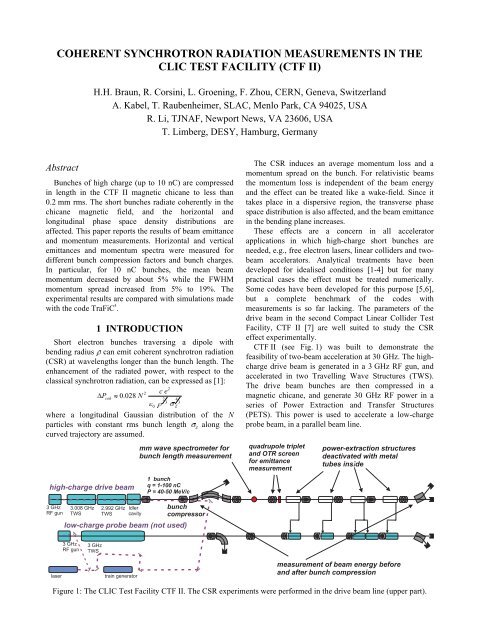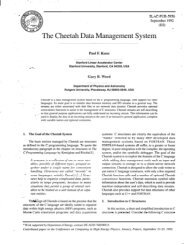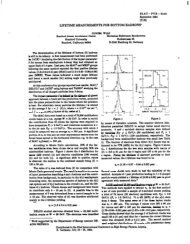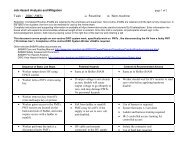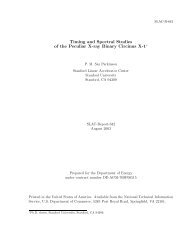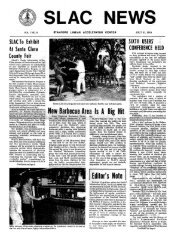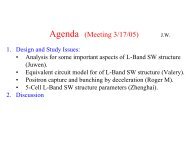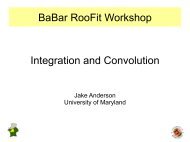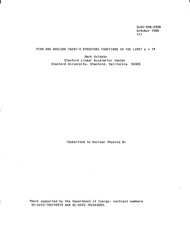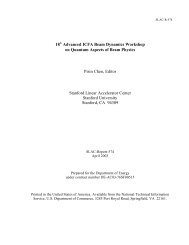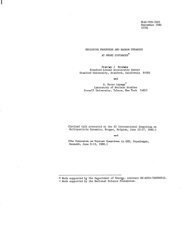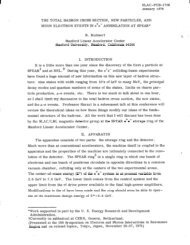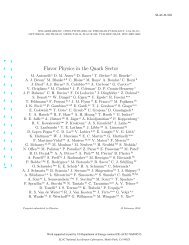slac-pub-8949 - SLAC - Stanford University
slac-pub-8949 - SLAC - Stanford University
slac-pub-8949 - SLAC - Stanford University
You also want an ePaper? Increase the reach of your titles
YUMPU automatically turns print PDFs into web optimized ePapers that Google loves.
COHERENT SYNCHROTRON RADIATION MEASUREMENTS IN THE<br />
CLIC TEST FACILITY (CTF II)<br />
H.H. Braun, R. Corsini, L. Groening, F. Zhou, CERN, Geneva, Switzerland<br />
A. Kabel, T. Raubenheimer, <strong>SLAC</strong>, Menlo Park, CA 94025, USA<br />
R. Li, TJNAF, Newport News, VA 23606, USA<br />
T. Limberg, DESY, Hamburg, Germany<br />
Abstract<br />
Bunches of high charge (up to 10 nC) are compressed<br />
in length in the CTF II magnetic chicane to less than<br />
0.2 mm rms. The short bunches radiate coherently in the<br />
chicane magnetic field, and the horizontal and<br />
longitudinal phase space density distributions are<br />
affected. This paper reports the results of beam emittance<br />
and momentum measurements. Horizontal and vertical<br />
emittances and momentum spectra were measured for<br />
different bunch compression factors and bunch charges.<br />
In particular, for 10 nC bunches, the mean beam<br />
momentum decreased by about 5% while the FWHM<br />
momentum spread increased from 5% to 19%. The<br />
experimental results are compared with simulations made<br />
with the code TraFiC 4 .<br />
1 INTRODUCTION<br />
Short electron bunches traversing a dipole with<br />
bending radius U can emit coherent synchrotron radiation<br />
(CSR) at wavelengths longer than the bunch length. The<br />
enhancement of the radiated power, with respect to the<br />
classical synchrotron radiation, can be expressed as [1]:<br />
2<br />
2 c e<br />
' P | 0.028 N<br />
coh<br />
2 4<br />
3 3<br />
H 0 U V Z<br />
where a longitudinal Gaussian distribution of the N<br />
particles with constant rms bunch length V Z<br />
along the<br />
curved trajectory are assumed.<br />
The CSR induces an average momentum loss and a<br />
momentum spread on the bunch. For relativistic beams<br />
the momentum loss is independent of the beam energy<br />
and the effect can be treated like a wake-field. Since it<br />
takes place in a dispersive region, the transverse phase<br />
space distribution is also affected, and the beam emittance<br />
in the bending plane increases.<br />
These effects are a concern in all accelerator<br />
applications in which high-charge short bunches are<br />
needed, e.g., free electron lasers, linear colliders and twobeam<br />
accelerators. Analytical treatments have been<br />
developed for idealised conditions [1-4] but for many<br />
practical cases the effect must be treated numerically.<br />
Some codes have been developed for this purpose [5,6],<br />
but a complete benchmark of the codes with<br />
measurements is so far lacking. The parameters of the<br />
drive beam in the second Compact Linear Collider Test<br />
Facility, CTF II [7] are well suited to study the CSR<br />
effect experimentally.<br />
CTF II (see Fig. 1) was built to demonstrate the<br />
feasibility of two-beam acceleration at 30 GHz. The highcharge<br />
drive beam is generated in a 3 GHz RF gun, and<br />
accelerated in two Travelling Wave Structures (TWS).<br />
The drive beam bunches are then compressed in a<br />
magnetic chicane, and generate 30 GHz RF power in a<br />
series of Power Extraction and Transfer Structures<br />
(PETS). This power is used to accelerate a low-charge<br />
probe beam, in a parallel beam line.<br />
Figure 1: The CLIC Test Facility CTF II. The CSR experiments were performed in the drive beam line (upper part).


